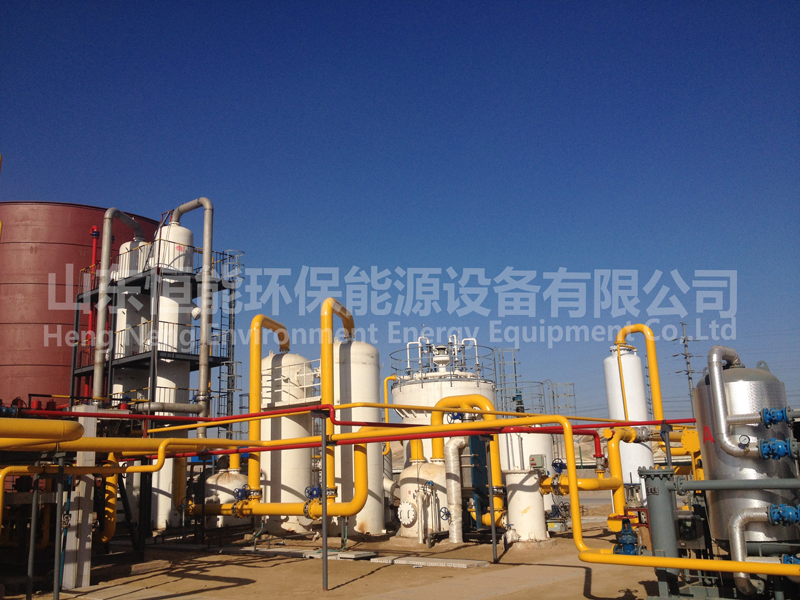欢迎进入山东恒能环保能源设备有限公司
欢迎进入山东恒能环保能源设备有限公司
在可再生能源利用领域,沼气脱硫技术是保障系统安全运行与能源品质的关键环节。作为沼气净化处理的核心工序,脱硫工艺直接关系到沼气的利用效率与环保合规性。本文将从技术本质出发,系统阐述沼气脱硫的核心原理及其工程价值。
In the field of renewable energy utilization, biogas desulfurization technology is a key link to ensure the safe operation of the system and energy quality. As the core process of biogas purification treatment, desulfurization technology is directly related to the utilization efficiency and environmental compliance of biogas. This article will start from the essence of technology and systematically explain the core principles and engineering value of biogas desulfurization.
硫化氢的危害本质
The essence of the hazards of hydrogen sulfide
沼气中的硫化氢是典型的腐蚀性气体,其危害体现在三个维度:对金属设备的电化学腐蚀速率可达普通环境的5倍;与水汽结合形成的酸性溶液会侵蚀管道内壁;燃烧后生成的二氧化硫是PM2.5的重要前体物。当沼气中硫化氢浓度超过50ppm时,设备腐蚀风险呈指数级上升,必须通过脱硫工艺将其浓度控制在1ppm以下。
Hydrogen sulfide in biogas is a typical corrosive gas, and its hazards are reflected in three dimensions: the electrochemical corrosion rate of metal equipment can reach 5 times that of ordinary environments; The acidic solution formed by combining with water vapor will corrode the inner wall of the pipeline; The sulfur dioxide generated after combustion is an important precursor of PM2.5. When the concentration of hydrogen sulfide in biogas exceeds 50ppm, the risk of equipment corrosion increases exponentially, and its concentration must be controlled below 1ppm through desulfurization technology.
化学吸收法的技术逻辑
The technical logic of chemical absorption method
化学吸收法是当前主流的脱硫技术路线,其核心在于构建气液传质界面。沼气以0.1-0.3m/s的线速度通过填料塔,与逆向流动的碱性吸收液充分接触。吸收液中的氢氧化钠或碳酸钠与硫化氢发生中和反应,生成硫化钠或硫氢化钠。该反应的平衡常数达10^19量级,可确保硫化氢去除效率突破99%。吸收液再生系统通过蒸汽汽提或空气氧化技术,使硫化物转化为单质硫回收,形成闭环处理体系。
Chemical absorption method is currently the mainstream desulfurization technology route, and its core lies in constructing a gas-liquid mass transfer interface. Biogas passes through the packed tower at a linear velocity of 0.1-0.3m/s and comes into full contact with the alkaline absorbent flowing in the opposite direction. Sodium hydroxide or sodium carbonate in the absorption solution undergoes a neutralization reaction with hydrogen sulfide to produce sodium sulfide or sodium hydrosulfide. The equilibrium constant of this reaction is on the order of 10 ^ 19, ensuring a hydrogen sulfide removal efficiency of over 99%. The absorption liquid regeneration system uses steam stripping or air oxidation technology to convert sulfides into elemental sulfur for recovery, forming a closed-loop treatment system.
生物氧化法的创新突破
Innovative breakthrough in biological oxidation method
生物脱硫技术模拟自然界的硫循环过程,通过驯化培养的硫氧化细菌实现硫化氢的生物转化。在生物滤池中,沼气以0.05-0.1m/s的空床气速通过填料层,硫化氢被微生物分泌的细胞色素氧化酶催化,转化为单质硫沉积在生物膜表面。该技术的突破性在于将化学能转化为生物能,运行能耗较化学法降低60%以上。关键控制参数包括:填料层湿度维持在50%-70%,pH值精确控制在7.5-8.5区间,温度保持在25-35℃的最适生长范围。
Biological desulfurization technology simulates the natural sulfur cycle process and achieves the biotransformation of hydrogen sulfide through domesticated sulfur oxidizing bacteria. In the biofilter, biogas passes through the packing layer at an empty bed gas velocity of 0.05-0.1m/s, and hydrogen sulfide is catalyzed by cytochrome oxidase secreted by microorganisms to be converted into elemental sulfur and deposited on the surface of the biofilm. The breakthrough of this technology lies in the conversion of chemical energy into bioenergy, which reduces operating energy consumption by more than 60% compared to chemical methods. The key control parameters include: maintaining the humidity of the packing layer at 50% -70%, accurately controlling the pH value within the range of 7.5-8.5, and maintaining the temperature within the optimal growth range of 25-35 ℃.

物理吸附法的工艺特性
Process characteristics of physical adsorption method
对于低浓度沼气(硫化氢<1000ppm),物理吸附法展现出独特优势。活性炭基吸附剂通过微孔结构产生的范德华力捕获硫化氢分子,当吸附容量达到饱和后,可采用热氮气再生技术恢复吸附性能。新型金属有机框架材料(MOFs)的应用使吸附容量提升3倍,穿透时间延长至48小时以上。该技术路线无二次污染产生,特别适用于分布式沼气处理场景。
For low concentration biogas (hydrogen sulfide<1000ppm), physical adsorption method exhibits unique advantages. Activated carbon based adsorbents capture hydrogen sulfide molecules through van der Waals forces generated by their microporous structure. When the adsorption capacity reaches saturation, hot nitrogen regeneration technology can be used to restore the adsorption performance. The application of new metal organic framework materials (MOFs) has increased the adsorption capacity by three times and extended the penetration time to over 48 hours. This technology route generates no secondary pollution and is particularly suitable for distributed biogas treatment scenarios.
技术选型的工程考量
Engineering considerations for technology selection
脱硫工艺选择需综合评估三项要素:沼气组分中硫化氢浓度波动范围、后续利用方式对硫含量的要求、系统运行维护的便捷性。对于畜禽粪污沼气等硫化氢浓度波动大的原料,推荐采用化学-生物联合工艺;当沼气用于燃气发电时,需配置两级脱硫系统确保硫含量≤10ppm;对于偏远地区的小型沼气工程,模块化生物脱硫装置可显著降低全生命周期成本。
The selection of desulfurization process requires a comprehensive evaluation of three factors: the fluctuation range of hydrogen sulfide concentration in biogas components, the requirements for sulfur content in subsequent utilization methods, and the convenience of system operation and maintenance. For raw materials with large fluctuations in hydrogen sulfide concentration such as livestock manure, biogas, etc., it is recommended to use a chemical biological combined process; When biogas is used for gas-fired power generation, a two-stage desulfurization system should be configured to ensure that the sulfur content is ≤ 10ppm; For small-scale biogas projects in remote areas, modular biological desulfurization devices can significantly reduce the total lifecycle cost.
沼气脱硫技术的本质是构建硫化氢的迁移转化路径,通过化学、生物、物理方法的协同作用,实现能源清洁化与设备耐久性的平衡。随着环保标准的趋严和能源利用效率要求的提升,脱硫工艺正从末端治理向源头控制演进,为沼气产业的可持续发展提供关键技术支撑。
The essence of biogas desulfurization technology is to construct a migration and transformation pathway for hydrogen sulfide, achieving a balance between energy cleanliness and equipment durability through the synergistic effect of chemical, biological, and physical methods. With the tightening of environmental standards and the increasing demand for energy efficiency, desulfurization processes are evolving from end of pipe treatment to source control, providing key technical support for the sustainable development of the biogas industry.
本文由沼气脱硫友情奉献.更多有关的知识请点击:https://www.hneee.net我们将会对您提出的疑问进行详细的解答,欢迎您登录网站留言.
This article is a friendly contribution from biogas purification For more information, please click: https://www.hneee.net We will provide detailed answers to your questions. You are welcome to log in to our website and leave a message